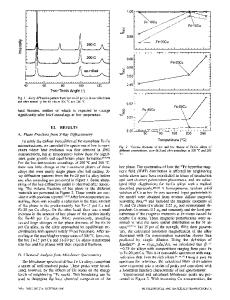Indentation creep in nanocrystalline Fe-TiN and Ni-TiN alloys prepared by mechanical alloying
- PDF / 563,622 Bytes
- 8 Pages / 612 x 792 pts (letter) Page_size
- 2 Downloads / 310 Views
I.
INTRODUCTION
THE grain size refinement of metal-ceramic composites into nanometer size range below 100 nm is of interest because of the expectation that the nanoscale refinement will enhance mechanical properties, such as strength and hardness, possibly without loss of ductility or even with improved ductility. The capability of superplastic forming at moderate temperatures and strain rates is also an attractive expectation for the nanoscale refinement. On the other hand, the nanoscale refinement should accelerate significantly the rate of grain boundary sliding or diffusional creep because of the increase in volume fraction of grain boundaries and triple junctions, and also of the decrease in diffusion distance. Therefore, it has been suggested in many studies on nanocrystalline (n) materials that a transition in deformation mechanism from dislocation mechanism to a diffusional one occurs at low temperatures with decreasing grain size.[1,2] Chang et al.[3] have shown by an indentation creep test of n-TiAl that it softens at room temperature with a decreasing grain size below about 30 nm. They ascribed this softening to diffusional creep and suggested that ductility is improved by the softening. Ductility increase due to the accelerated diffusional creep has been suggested in many other studies on n-materials. The grain size and temperature dependences of creep deformation mechanisms would be, therefore, of fundamental importance for the mechanical response of nanocrystalline hard materials. However, studies providing definite experimental evidences for mechanisms of low temperature creep in n-materials are very limited to date. We aimed, in the present study, to investigate the grain size dependence of hardness and the indentation creep mechanism of n-Fe-TiN and n-Ni-TiN composite alloys prepared by dynamic consolidation of mechanically alloyed powders. High densities and high structural stabilities of these n-materials enabled us to investigate the creep behavior for a wide temperature range below 0.5 Tm (Tm is the melting temperature of iron and nickel). It will be shown
in the present study that the creep deformation at intermediate temperatures occurs by a dislocation mechanism controlled by grain boundary diffusion, not diffusional creep, as suggested in several studies. II.
Fe-63 vol pct TiN and Ni-17, 44, and 64 vol pct TiN powder alloys were prepared by ball milling Fe50Ti50 and Ni1002X TiX (X 5 10, 30, or 50) powder mixtures under a nitrogen gas atmosphere.[4,5] The ball milling was performed using a vibrational ball mill in which the vial and balls were made of SUS316 and 304 stainless steels, respectively. By milling for 360 to 540 ks, almost all the titanium atoms were nitrided to form cubic TiN, and n-Fe-TiN, and n-NiTiN dual-phase powder alloys were produced. Grain sizes in their microstructures were 4 to 10 nm. The Fe-TiN and Ni-TiN powders produced in this way were consolidated to bulk materials of 25 mm in diameter and 5 mm in thickness by dynamic compaction using a propellant gun. The dyna
Data Loading...











